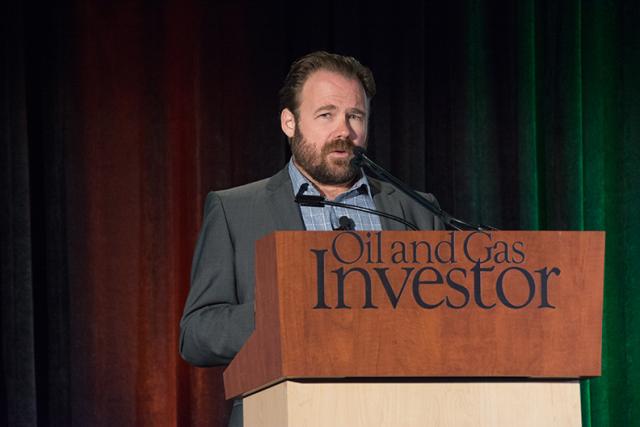
Meanwhile, RS Energy Group's Trevor Sloan said at the Energy Capital Conference that he has found fluid intensity in Permian Basin completions to be moderating to declining—counter to other plays. (Source: Hart Energy)
DALLAS—The Permian is still trending and it’s going to be for a long while, according to Trevor Sloan, co-head of research and advisory for RS Energy Group.
“Although it may have become quite tiresome, the U.S. Lower 48 story is a Permian story. It is sort of the great 800-pound gorilla sitting on the chest of everyone else out there,” he told attendees at the Energy Capital Conference hosted by Oil and Gas Investor.
“We’re starting to see a turnaround in both the Rockies and Gulf Coast a little bit, but it really is still a Permian story.”
The impact is evident in differentials, for example, that continue to be affected by growing amounts of Permian supply. “It is causing some problems,” Sloan said. “This is like the very successful child who goes out and starts doing some terrible things out in the world. This is basically what’s happening here.”
In 2014, the Midland and Delaware basins represented less than 20% of the Lower 48 horizontal rig count. Currently, they employ more than 40%, Sloan said. And these are the counts for the two basins; the percentage doesn’t include rigs drilling laterals on the Northwest Shelf and Central Basin Platform, he added.
Trending within the Midland Basin is “pretty relentless lateral-length increases even in a play that already had very long laterals,” he said. Lateral length has been consistently averaging 10,000 ft in RSEG’s last couple months of data.
Proppant volume continues to grow, but the pace of growth has been moderating during the last few months of data.
Oddly, though, fluid intensity seems to be leveling off. “Operators in the Midland are not wanting to put any more fluid per foot as in the past.”
In the Delaware, the analysis has produced similar findings—lateral length and proppant intensity are still growing. However, “fluid intensity has actually been falling,” he said.
“This is not what we’re seeing in a number of plays and it is counter to what we see in terms of driving results in key plays.” In the Eagle Ford, for example, proppant intensity has been leveling off, but fluid intensity continues to grow.
“Fluid intensity is the most important descriptor of individual well productivity…. But it’s interesting to see the Eagle Ford and the Bakken—in fluid intensity—moving in a different direction than each of the Permian plays,” he said.
In response to a question about operators reporting type curves that are consistently better than average, Sloan said, “Yeah, Lake Wobegon. Absolutely.”
The RSEG analysts produce a “type curve compendium” each year with 180 operators’ type curves from their presentations, comparing them with well data. Sloan said, “The surprising result is that they’re not necessarily overstated. About two-thirds of companies were actually reasonably close to hitting their curves.”
He conceded, “I love company [type-curve] presentations. They’re aspirational projects. They’re really hopeful documents. What you don’t always have is the underlying sample set—what’s being included, what’s being taken out.
“It doesn’t mean you don’t exclude some wells that aren’t representative, but it’s getting harder and harder to understand what’s actually driving that productivity.”
Certain from comparison with well data, however, is “the industry’s done a great job of driving improved productivity and well performance…. We haven’t seen in the past few years deteriorating well performance.”
Nissa Darbonne can be reached at ndarbonne@hartenergy.com.
Recommended Reading
Novel EOR Process Could Save Shale from a Dry Future
2024-12-17 - Shale Ingenuity’s SuperEOR, which has been field tested with positive results, looks to remedy the problem of production declines.
Microseismic Tech Breaks New Ground in CO2 Storage
2025-01-02 - Microseismic technology has proved its value in unconventional wells, and new applications could enable monitoring of sequestered CO2 and facilitate geothermal energy extraction.
Permanent Magnets Emerge as a Game-Changer for ESP Technology
2024-12-19 - In 2024, permanent magnet motors installations have ballooned to 11% of electric submersible pump installations, and that number is growing.
Pioneer Energy’s Tech Offers More Pad Throughput, Fewer Emissions
2025-01-14 - Pioneer Energy’s Emission Control Treater technology reduces emissions and can boost a well’s crude yield by 5% to10%, executives say.
BYOP (Bring Your Own Power): The Great AI Race for Electrons
2025-01-06 - Data-center developers, scrambling to secure 24/7 power, are calling on U.S. producers to meet demand as natgas offers the quickest way to get more electrons into the taps.
Comments
Add new comment
This conversation is moderated according to Hart Energy community rules. Please read the rules before joining the discussion. If you’re experiencing any technical problems, please contact our customer care team.






